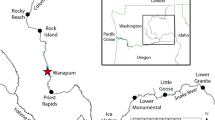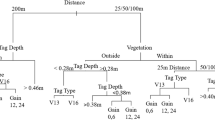Abstract
A fish protection system has been installed in a power canal at a hydroelectric facility on the Exploits River, Grand Falls-Windsor, Newfoundland, Canada. The river has an anadromous Atlantic salmon (Salmo salar)population in the order of 30000 returning adults. A louver and bypass were installed to protect downstream migrating smolt and kelt from entering the penstocks and turbines in the power canal at the generating facility. The efficiency and effectiveness of this protection system has been evaluated since 1997 through a combination of conventional telemetry, use of a digital spectrum processing (DSP) telemetry system with multiple antennae array, floy tagging, and velocity profiling along the louver array and throughout the canal. Initial monitoring in 1997 using conventional telemetry indicated low fish guidance efficiencies (FGEs) in the area of 25% for smolt. In 1998, a DSP telemetry system was installed along the louver array to attempt to identify problem areas where fish were passing through or under the louver. This work also recorded low smolt FGEs in 1998 (24.3%). However, the DSP system did identify sites along the louver array where fish were being lost, and hydraulic measurements suggested fish loss was related to hydraulic turbulence and irregularities in the guidance velocities. In 1999, a scale model of the power canal and bypass system was constructed at the University of Waterloo Engineering Department's Hydraulic Laboratory and a number of structural and operational changes to the system were evaluated. Based on the results of laboratory hydraulic modeling and DSP telemetry, a number of changes were made to the louver and bypass, prior to operation in 1999 and 2000. Monitoring of smolt out migration in 1999 and 2000 indicated a substantial improvement in smolt FGEs to 54.0 and 65.3%, respectively, and the DSP system identified areas where further improvements could be made. This paper demonstrates the utility of a sophisticated telemetry system in the evaluation of fish protection systems and how the technology can be applied towards the optimization of the effectiveness of fish by-passes.
Similar content being viewed by others
References
Anderson, W. G., R. S. McKinley & M. V. Colavecchia, 1997. The use of clove oil as an anaesthetic for rainbow trout and its effects on swimming performance. N. am. J. Fish. Manage. 17: 302-307.
Applied Biometrics Inc., 1998. Atlantic salmon out-migration program, 1998. Report prepared for Abitibi Consolidated Inc., Grand Falls, Newfoundland: 122 pp.
Applied Biometrics Inc., 1999. Atlantic salmon out-migration program, 1999. Report prepared for Abitibi Consolidated Inc., Grand Falls, Newfoundland: 73 pp.
Applied Biometrics Inc., 2000. Atlantic salmon out-migration program, 2000. Report prepared for Abitibi Consolidated Inc., Grand Falls, Newfoundland: 93 pp.
Bates, D. W. & Vinsonhaler, R. 1957. Use of louvers for guiding fish. Trans. am. Fish. Soc. 86: 38-57.
Beak International Inc., 1997. Atlantic salmon out-migration program, 1997. Abitibi Consolidated, Grand Falls Hydroelectric Facilities, Exploits River watershed, Grand Falls, Newfoundland. Report prepared for Abitibi Consolidated Inc., Grand Falls, Newfoundland: 42 pp.
Coutant, C. C. & R. R. Whitney, 2000. Fish behavior in relation to passage through hydropower turbines: a review. Trans. am. Fish. Soc. 129: 351-380.
Ducharme, L. J. A., 1972. An application of louver deflectors for guiding Atlantic salmon (Salmo salar) smolts from power turbines. J. Fish. Res. Bd. Can. 29: 1397-1404.
EPRI (Electric Power Research Institute), 1986. Assessment of downstream migrant fish protection technologies for hydroelectric application. EPRI AP-4711, Palo Alta, California.
Goosney, R. G., 1997. An efficient diversion/bypass system for Atlantic salmon (Salmo salar) smolt and kelt in power canals. Proceedings of a Fish Passage Workshop, Milwaukee, Wisconsin, May 6-8, 1997: 7 pp.
Hocutt, C. H., 1980. Behavioral barriers and guidance systems. In Hocutt, C. H., J. R. Stauffer, J. E. Edinger, L. W. Hall & R. Morgan II (eds), Power Plants: Effects on Fish and Shellfish Behavior. Academic Press, New York: 183-205.
Hocutt, C. H. & J. E. Edinger, 1980. Fish behavior in flow fields. In Hocutt, C. H., J. R. Stauffer, J. E. Edinger, L. W. Hall & R. Morgan II (eds), Power Plants: Effects on Fish and Shellfish Behavior. Academic Press, New York: 143-181.
Kouwen, N., D. Roche & J. Innes, 1999. Physical model study of the Grand Falls canal and behavioural louver fish diversion system. Report for Abitibi Consolidated Inc, Grand Falls, Newfoundland: 44 pp.
McKinley, R. S. & P. H. Patrick, 1988. Influence of three sonic devices on fish behaviour. In Clowes, B. W. (ed.), Waterpower '87: Proceedings of the International Conference on Hydropower, 19-21 August, 1987, Portland, Oregon. Vol. 1. Am. Soc. Civ. Engin. New York, NY: 542-560
Nettles, D. C. & S. P. Gloss, 1987. Migration of landlocked Atlantic salmon smolts and effectiveness of a fish bypass structure at a small scale hydroelectric facility. N. am. J. Fish.Manage. 7: 562-568.
O'Connell, M. F. & C. E. Bourgeois, 1987. Atlantic Salmon Enhancement in the Exploits River, Newfoundland, 1957-1984. N. am. J. Fish. Manage. 7: 207-214.
Patrick, P. H., R. S. McKinley & W.C. Micheletti, 1988. Field testing of behavioural barriers for cooling water intake structures-test site 1-Pickering nuclear generating station-1985/86. In Proceedings: Fish Protection at Steam and Hydroelectric Power Plants. Electrical Power Research Institute, EPRI CS/EA/AP-5663-SR. Palo Alto, CA: 4-13-4-25.
Prentice, E. F., T. A. Flagg, C. S. McCutcheon, D. F. Brastow & D. C. Cross, 1990. Equipment, methods, and an automated dataentry station for PIT tagging. Am. Fish. Soc. Symp. 7: 335-340.
Ruggles, C. P. & P. Ryan, 1964. An investigation of louvers as a method of guiding juvenile Pacific salmon. Can. Fish Cult. 33: 3-67.
Ruggles, C. P., 1980. A review of the downstream migration of Atlantic salmon. Can. Tech. Rep. Fish. aquat. Sci. 952: 39 pp.
Ruggles, C. P., D. A. Robinson & R. J. Stira, 1993. The use of floating louvers for guiding Atlantic salmon smolts from hydroelectric turbine intakes. In Williams, U. P., D. A. Scruton, R. F. Goosney, C. E. Bourgeois, D. C. Orr & C. P. Ruggles (eds), Proceedings of the Workshop on Fish Passage at Hydroelectric Developments, 26-28 March 1991. St. John's, Newfoundland. Can. Tech. Rep. Fish. aquat. Sci. 1905: 87-94.
Taylor, V. R. & B. R. Bauld, 1973. A program for increased Atlantic salmon (Salmo salar) production on a major Newfoundland River. In Smith, M. W. & W. M. Carter (eds), Proceedings of the International Symposium on the Atlantic Salmon: Management, Biology and Survival of the Species. International Atlantic Salmon Foundation Special Publication Series, 4(1), St.Andrews, New Brunswick: 339-347.
Taft, E. P.&E. Bazarian, 1983. State-of-the-art in preventing turbine mortality at hydro facilities. Stone and Webster Report, TP 83-79: 16 pp.
U.S. Congress, Office of Technologies Assessment, 1995. Fish Passage Technologies: Protection at Hydropower facilities. OTAENV-641. Washington, DC, U.S. Government Printing Office, 1995: 167 pp.
Winter, J. D., 1983. Underwater biotelemetry. In Nielsen, L. A. & D. L. Johnson (eds), Fisheries Techniques. American Fisheries Society, Bethesda, Maryland: 371-395.
Author information
Authors and Affiliations
Rights and permissions
About this article
Cite this article
Scruton, D., McKinley, R., Kouwen, N. et al. Use of telemetry and hydraulic modeling to evaluate and improve fish guidance efficiency at a louver and bypass system for downstream-migrating Atlantic salmon (Salmo salar) smolts and kelts. Hydrobiologia 483, 83–94 (2002). https://doi.org/10.1023/A:1021350722359
Issue Date:
DOI: https://doi.org/10.1023/A:1021350722359




